june-top.html
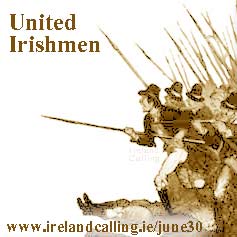 1798 The Battle of Ballyellis took place on this day in 1798. It was one of numerous conflicts that took place between the United Irishmen, who were trying to take control of Ireland, and the British Army, who were ordered to crush the rebellion.
1798 The Battle of Ballyellis took place on this day in 1798. It was one of numerous conflicts that took place between the United Irishmen, who were trying to take control of Ireland, and the British Army, who were ordered to crush the rebellion.
This battle was significant because it sent a warning back to the British authorities in Dublin that the rebels weren’t finished yet.
The British Army had managed to drive the rebels out of Wexford after a series of victories. The authorities had hoped that the rebels’ spirit and resolve would be low as a result of losing hundreds of men in recent weeks.
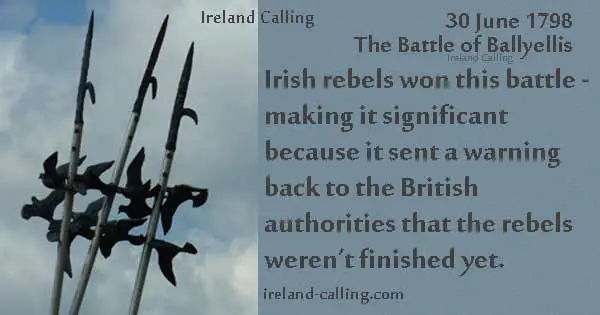
That may have been the case but the rebels weren’t finished with their uprising. They had headed inland to join up with other United Irishmen groups and spread the rebellion.
The Battle of Ballyellis took place when a group of rebels who were being tracked by the British set up an ambush for their pursuers. The British thought they were chasing the rebels away, when in fact now the rebels were waiting for them.
The rebels waited by the roadside by the covering of a wall and high ditches in Ballyellis. A small number were sent into the road to bait the oncoming British army. The army spotted the rebels and believed they were just the tail end of the unit that was fleeing, and so charged in full speed. They were met by hundreds more rebels appearing from beneath the roadside and slaughtered by gunshots and pikes.
The British soldiers tried to escape but were pursued across the surrounding fields and killed by the rebels. Only a handful of the British soldiers managed to escape with their lives, with around 60 being slaughtered. The report went back to the authorities in Dublin, who sent for reinforcements to cut off the rebels unit at County Wicklow.
* * *
1916 Sir Roger Casement was stripped of his knighthood. He was the son of a British army officer but a committed Irish nationalist. The previous day, 29 June, he had been sentenced to death for taking part in the Easter Rising.
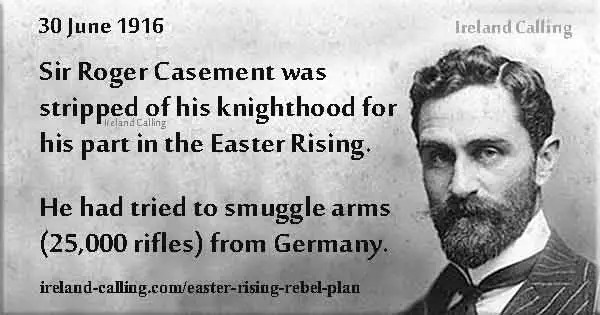
Discover more about the rebel plan plus video of The Wolfe Tones singing Banna Strand – story of Roger Casement who fought for Ireland against the British.
* * *
1922 Rory O’Connor surrendered the Four Courts buildings in Dublin on this day in 1922.
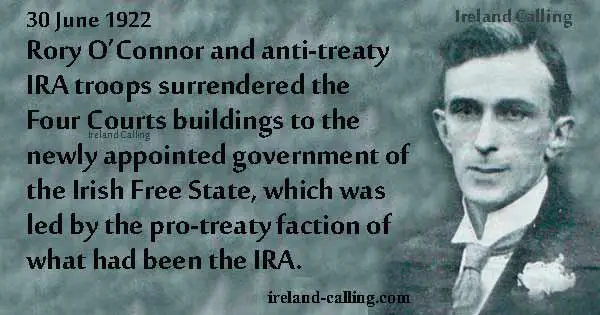
He had led his anti-treaty IRA troops for two days as they attempted to seize the buildings from the newly appointed government of the Irish Free State, which was led by the pro-treaty faction of what had been the IRA.
The organisation was now split and a Civil War that lasted nearly a year followed. O’Connor was arrested and tried for treason and sentenced to death by the Free State government.
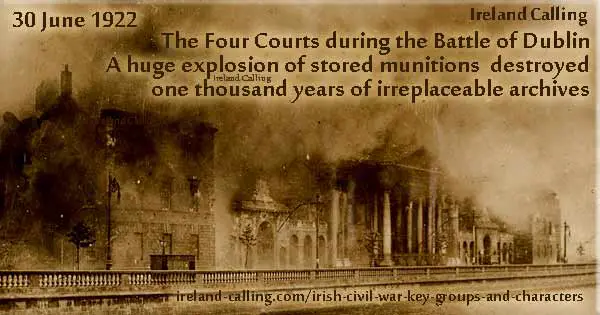
 The man who ordered O’Connor’s execution was Kevin O’Higgins. O’Higgins and O’Connor had been comrades and friends as part of the IRA before the signing of the Anglo-Irish Treaty created a split.
The man who ordered O’Connor’s execution was Kevin O’Higgins. O’Higgins and O’Connor had been comrades and friends as part of the IRA before the signing of the Anglo-Irish Treaty created a split.
O’Higgins had asked O’Connor to be the best man at his wedding less than a year before, and now he was giving the order for his execution.
The two men’s relationship shows how split the country had become by 1922, with passion and anger on both sides of the divide.
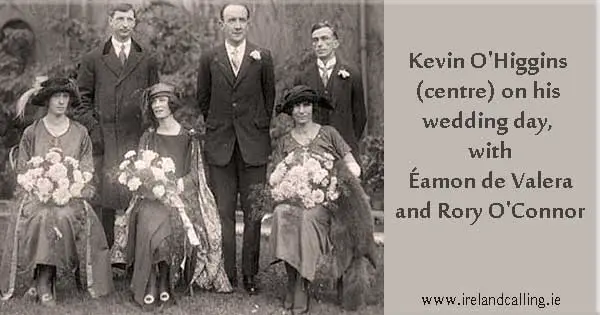
Find out the key characters and groups from the Irish Civil War
* * *
1941 Stephen Hayes was kidnapped by the IRA on this day in 1941. He was actually a member, and leader, of the organisation but was kidnapped and tortured by his own men after they suspected he had become an informer.
Hayes was born in Wexford and had fought with the IRA during the Irish War of Independence. He again, fought for them, in the anti-treaty faction during the Irish Civil War.
Hayes was a senior member of the IRA by the outbreak of World War II. He took control of the organisation when its leader Seán Russell left the country for business in the USA and then Nazi Germany. The IRA were suspected of having links with the Nazis, in order to obtain arms to launch an attack on the British authorities in Northern Ireland.
In 1940, Hayes organised a meeting of leading IRA figures, but it was raided by the police. Two senior IRA figures who were wanted by the authorities, Paddy McGrath and Tom Harte, were arrested and handed the death sentence. There were suspicions within the IRA that Hayes had tipped off the authorities that McGrath and Harte would be at the meeting.
Hayes kidnapped by IRA
He was kidnapped by the IRA and tortured. Hayes claimed that he was court-martialled for treason and would have been executed had he not stalled for time by making up a long drawn-out confession. He managed to escape and turned himself in to the Garda for his own protection. He was given a five year prison sentence for his own IRA actions of the past.
Seán McCaughey, the leader of a Northern strand of the IRA, was later arrested for Hayes’ kidnapping. He denied the charge and died on hunger strike in prison.
* * *
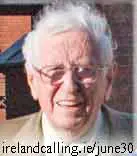 1981 Fine Gael leader Garret Fitzgerald became Taoiseach on this day in 1981. He replaced Charles Haughey, the leader of Fianna Fáil.
1981 Fine Gael leader Garret Fitzgerald became Taoiseach on this day in 1981. He replaced Charles Haughey, the leader of Fianna Fáil.
However, Fitzgerald held onto power for less than a year before Haughey was voted back in. He did regain power a short time later though, and remained as Taoiseach for much of the 1980s.
* * *
1990 Ireland’s World Cup dream ended on this day in 1990, when they were beaten 1-0 in the quarter-finals by hosts Italy. It had been a hugely successful first tournament for the Irish, but ended with them unable to muster an equaliser against the classy Italians.
The squad, and manager Jack Charlton, returned home as heroes. The success of the team in 1990 saw a significant shift in Irish public opinion of football. It was seen by some as a ‘foreign game’ with Gaelic Football and Hurling the traditional national sports. Both those sports have remained mainstays of Irish sport, but football has rapidly grown in popularity over the past twenty years or so.
* * *
2003 Constance Smith died in London on this day in 2003. She was a movie star in the 1950s, but her career and life went on a sad downward spiral from there. Smith was born in Limerick, the eldest of eleven children. Her father died when she was 11, and her mother sent her to a convent as she was unable to support the whole family.
When she was 16, Smith’s photo was sent to a film company by her mother, and she was offered a screen test in London. She went under pressure from her mother, but was sacked by the company because of her bad attitude. She studied acting in London and had roles in several minor films.
Smith was spotted by an American film maker who invited her to Hollywood. She acted in several movies without ever convincing directors she had ‘star quality’. Smith was becoming a familiar face in Hollywood though and presented the Academy Awards in 1952.
Unfortunately after that her career began to nosedive. Her marriage broke down and as a result of her emotional distress, she couldn’t get the parts she wanted, and didn’t want the parts she could get. Smith began drinking and taking drugs heavily and attempted suicide. During this period she also married for the second time, to English film director Bryan Forbes but the relationship was short-lived.
In 1962, she was sent to prison for stabbing her boyfriend. They later got married but Smith was charged with attempted murder when she stabbed him again. She tried to kill herself on more than one occasion as a result of the break-up of her third marriage.
Tragically, Smith’s lived out the remainder of her life suffering with illness and poverty. She spent much of her time in and out of hospitals, and worked as a cleaner when she was fit enough to do so. She died at the age of 75 in London on 30 June 2003.
june-bottom.html